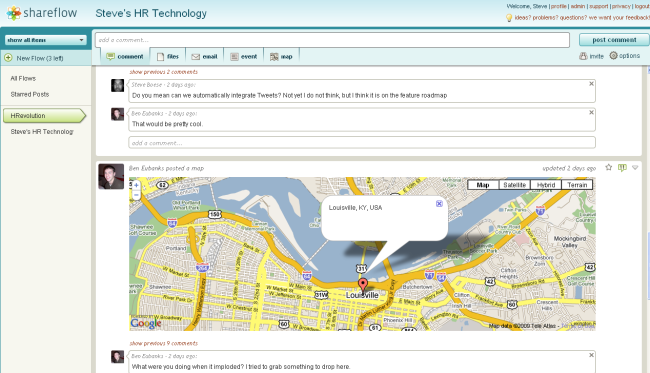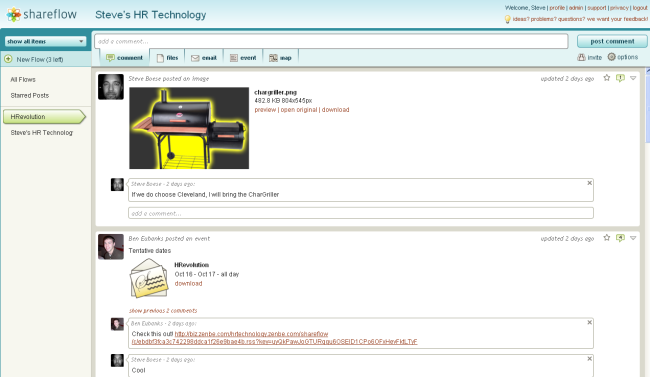So by now unless you have been under a rock for the last two months you have heard about Google Wave, the upcoming tool from Google that promises to radically change the way people collaborate by merging or mashing up content (web pages, images, documents, social networking, etc.).
But Google Wave is several months away from launch, and if you are anxious to get a feel for a Wave-like experience, perhaps you should give Shareflow a try.
What is it?
Shareflow is a tool for collecting updates from team members and organizing them in a live stream, called a 'Flow' that similar to a Twitter stream or a Facebook page. Short updates, links, or attached files most typically sent via email are the types of updates that will be captured in a Flow.
These Flows can be shared to unlimited participants by using a simple 'Invite' link, and once the new user follows the extremely simple registration process they can get straight to collaborating on the Flow.
Also, since offering an alternative to email collaboration is a prime use case of Shareflow, each flow has a unique email address that Flow participants can use to forward or copy emails right in to the Flow.

What's so cool about it?
But where the tool shows its strength, and earns is comparisons with Wave, is when multiple participants in the Flow are collaborating in real-time. Keeping the flow open and 'live' so to speak lets you share information and comments with the other members of the flow in a neat, seamless manner.
Folks can scroll down the Flow to see how information or concepts were developed. While it does not offer the dynamic 'replay' capability that is promised in Google Wave, this ability to collect and make available the history of a stream is far superior to a typical email centric work process.

The embedded Google Maps capability is really neat, simply type in an address, an the Flow auto-generates a Google Map on the spot. Additionally, Sharefow provides RSS feeds of each flow, enabling easy subscription to flow changes and additions in a feed reader and sends an optional daily e-mail digest to Flow participants. Finally, in a really cool feature, Shareflow enables drag and drop from your computer right into the Flow, simply highlight some content with your mouse, and drag it into the Flow and it automatically creates a new 'item' in the Flow.
Who can use this
I see a few obvious use cases for Shareflow; a group of students collaborating on a research project could set up a Flow for all members to share articles, links, and other content as part of the data gathering process. People trying to organize or plan an event could leverage the platform in this manner as well. Since the Flow 'owner' can invite anyone to participate in the flow, project teams can easily collaborate with customers, prospects, or contractors on projects, without having to grant access to all of their flows to external users. Even an individual gathering ideas for a blog post or article could easily set up a flow to capture notes, ideas, etc in a really easy, lightweight manner. Really any time a give and take, or a simple exchange of ideas and comments needs to happen, a Flow might be a great solution.
How do I get started?
Go to www.getshareflow.com and register. Shareflow offers a free plan that allows 5 active flows and up to 25MB of storage, and from there you can upgrade to paid plans ranging from $20-$80 monthly that both increase the number of flows you can create and upgrade the file storage limits.
I encourage you to give Shareflow a try, if nothing else to get yourself just a taste of what working with Google Wave might be like in the future.
Note : Thanks to Ben Eubanks from the UpstartHR blog who helped me do some testing and provided some good feedback on Shareflow.